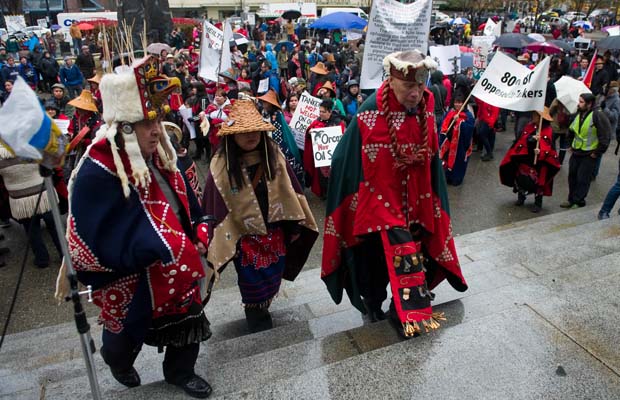Rejecting the recent approval of Enbridge’s Northern Gateway pipeline, which would transport tar sands oil from Alberta to the British Columbia coast, Canada’s First Nations groups have asserted that it is illegal for the government to approve any such project without consulting First Nations.
“Our position is that before a decision can be made, there has to be a complete report in accordance with the law — and the report was flawed, so the government cannot legally make the decision,” said a staff lawyer for EcoJustice, Barry Robinson. “If the courts find we are correct, then the decision made… would have to be reversed.”
First Nations groups have asserted that under the Constitution of Canada, the government legally must consult First Nations and accommodate First Nations treaties in decisions that could impact First Nations lands and resources.
Two sections of Canada’s constitution deal specifically with native rights.
A provision in the Constitution of Canada–Section 35–although debated, has been found by courts to protect to First Nations treaty rights regarding fishing, logging, hunting and right to First Nations land.
The text reads,
35. (1) The existing aboriginal and treaty rights of the aboriginal peoples of Canada are hereby recognized and affirmed.
(2) In this Act, “Aboriginal Peoples of Canada” includes the Indian, Inuit and Métis peoples of Canada.
(3) For greater certainty, in subsection (1) “treaty rights” includes rights that now exist by way of land claims agreements or may be so acquired.
(4) Notwithstanding any other provision of this Act, the aboriginal and treaty rights referred to in subsection (1) are guaranteed equally to male and female persons.
A part of the Constitution of Canada–the Charter of Rights and Freedoms, which guarantees the civil rights and liberties of every citizen in Canada–also provides for native rights, in Part II. Section 25 of the Charter insures that the Charter must be enforced in a way that does not diminish First Nations rights, and reads,
The guarantee in this Charter of certain rights and freedoms shall not be construed as to abrogate or derogate from any aboriginal, treaty or other rights or freedoms that pertain to the aboriginal peoples of Canada including
(a) any rights or freedoms that have been recognized by the Royal Proclamation of October 7, 1763; and
(b) any rights or freedoms that now exist by way of land claims agreements or may be so acquired.
There is a difference between Section 35 of the Constitution and Section 25 of the Charter. Section 25 does not necassarily constitutionalize aboriginal rights, although it may protect some rights. Section 35 does constitutionalize some native rights.
Both Sections 25 and 35 were not originally written into the Constitution of Canada, but were reactions to strong protests by First Nations groups who protested the lack of guarantees for Aboriginal rights when the first draft of the constitution was being negotiated after the first version of the Charter was drafted in 1980. Prior to the inclusion of Sections 25 and 35, the Constitution only had the language of Section 26, which provides a guide for interpreting how the Charter should affect Canadian society. Section 26 reads,
The guarantee in this Charter of certain rights and freedoms shall not be construed as denying the existence of any other rights or freedoms that exist in Canada.
Section 26 requires that the Charter cannot be interpreted to deny that non-Charter rights exist–rights not within the Charter are nevertheless real as they would be if the Charter had never been written. The original 1980 draft of what would become Section 26 read provided that the Charter should not be construed as denying the existence of “any rights or freedoms that pertain to the native peoples of Canada.”
First Nations rights have been upheld in Canadian courts through Section 35 dating back to 1990, at which time a ruling handed down found that,
The constitutional recognition afforded by the provision [section 35], therefore, gives a measure of control over government conduct and a strong check on legislative power. While it does not promise immunity from government regulation in a society that, in the twentieth century is increasingly more complex, interdependent and sophisticated and where exhaustible resources need protection and management, it does hold the Crown to a substantive promise. The government is required to bear the burden of justifying any legislation which has some negative effect on any aboriginal right protected under section 35(1) (R. v. Sparrow [1990]).
Succeeding trials established that in fishing, logging, hunting and right to First Nations land, “the government must demonstrate that it has given the aboriginal fishery priority in a manner consistent with this Court’s [earlier decisions]” (R. v. Gladstone [1996]).
By Day Blakely Donaldson
